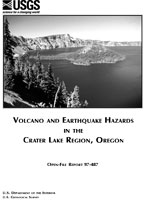Crater Lake lies in a basin, or caldera, formed
by collapse of the Cascade volcano known as Mount
Mazama during a violent, climactic eruption about
7,700 years ago. This event dramatically changed the
character of the volcano so that many potential types
of future events have no precedent there. This
potentially active volcanic center is contained within
Crater Lake National Park, visited by 500,000 people
per year, and is adjacent to the main transportation
corridor east of the Cascade Range. Because a lake is
now present within the most likely site of future
volcanic activity, many of the hazards at Crater Lake
are different from those at most other Cascade
volcanoes. Also significant are many faults near Crater
Lake that clearly have been active in the recent past.
These faults, and historic seismicity, indicate that
damaging earthquakes can occur there in the future.
This report describes the various types of volcano and
earthquake hazards in the Crater Lake area, estimates
of the likelihood of future events, recommendations
for mitigation, and a map of hazard zones. The main
conclusions are summarized below.


